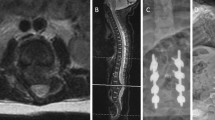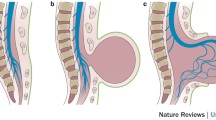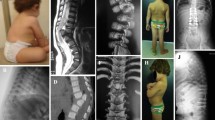Abstract
Patients with occult spinal dysraphisms may develop a variety of different complications as a result of the primary spine anomaly. These secondary complications are diverse and frequently require a multidisciplinary team of healthcare professionals including orthopedic surgeons, urologists, and neurologists, neurosurgeons, physiatrists, therapists, and others in order to achieve the best possible outcomes for affected patients. In this chapter, we outline the most common secondary complications of dysraphisms and describe the presentation and treatment strategy for these conditions.
Access provided by Autonomous University of Puebla. Download chapter PDF
Similar content being viewed by others
Keywords
Although neurological deficits and complaints resulting from spinal dysraphism are frequently the most obvious result of tethered cord [1] and the most likely to be recognized by a neurosurgeon, patient quality of life often depends on the proper recognition and management of secondary effects outside of the usual boundaries of the nervous system. Patients with occult spinal dysraphisms may develop a variety of different complications as a result of the primary spine anomaly. These secondary complications are diverse and frequently require a multidisciplinary team of healthcare professionals including orthopedic surgeons, urologists, and neurologists, neurosurgeons, physiatrists, physical and occupational therapists, and others in order to achieve the best possible outcomes for affected patients. Many patients with occult spinal dysraphism are diagnosed incidentally. Many of these patients will remain asymptomatic and may never require intervention. In general, lower conus position is associated with an increasing likelihood of symptomatic tethered spinal cord [2]. Patients with normal position conus are extremely unlikely to benefit from surgery. In this chapter, we outline the most common secondary complications of dysraphisms and describe the presentation, the treatment strategy, and, when known, the natural history for each of these conditions.
Cutaneous Associations of Spinal Dysraphism
Occult spinal dysraphism may present with characteristic cutaneous stigmata . The most well-known of these are the “faun tail” or hairy patch, a subcutaneous lipoma, hemangiomas, skin tags, nevi, and a dermal sinus tract [1, 3]. These lesions are found in many patients with occult spinal dysraphism and most commonly occur midline and in the lumbosacral coccygeal region [4,5,6]. The cutaneous lesions are often the initial finding that leads to a diagnosis of an underlying spinal abnormality [1, 3, 6].
Schropp et al. performed a prospective review of 358 children with occult spinal dysraphism to further characterize the associated cutaneous anomalies. They described 14 categories of cutaneous abnormalities, including subcutaneous lipoma, skin tag, deviation of the gluteal fold, coccygeal pit, atypical dimple (cranial to gluteal crease or outside the midline), porus/dermal sinus tract, skin dysplasia, a “cigarette burn” (scarred region), hemangioma, vascular nevus (not a true hemangioma), depigmented macula, hairy patch, hypertrichosis (more diffuse and less pronounced than the hairy patch), and meningocele [3]. In their study, 86.3% of patients had one or more cutaneous lesions. Subcutaneous lipoma was found most frequently, followed by vascular nevi and then sacral dimple, with 47.8%, 23.2%, and 10.6% incidence, respectively [3]. Zerah et al. divided cutaneous findings into three groups based on “risk” of finding an underlying spinal dysraphism. The “high risk” group includes subcutaneous lipoma, faun’s tail, dermal sinus, or two or more of any cutaneous lesion. These patients had a strong association with underlying spinal dysraphism and [1]. The “low risk” group included patients with an atypical dimple, aplasia cutis, or deviation of the gluteal furrow [1]. The “very low risk” group included hemangioma, port-wine stain, hypertrichosis, fibroma pendulum, pigmentary nevus, and coccygeal dimple [1].
Some cutaneous lesions seem to correlate with particular underlying dysraphisms on observation studies. For example, a hairy patch correlates highly with split cord malformation [3, 7], while hemangiomas are often associated with simple fatty filum with tethered cord syndrome [6]. Although there is no proof of a causal relationship, or direct correlation, observation of any of the mentioned high risk category cutaneous lesions should initiate further imaging work-up in the proper clinical context.
Dermal sinus tract is the most important cutaneous manifestation of spinal dysraphism to recognize and treat. Failure to diagnose a dermal sinus tract may not only result in undiagnosed occult spinal dysraphism and therefore failure to prevent urologic, orthopedic, and neurologic decline but also may result in meningitis or even spinal abscess [1, 3, 8]. In general, when a dermal sinus tract is diagnosed, surgical evaluation is recommended to prevent meningitis and abscess [6].
Orthopedic Complications of Spinal Dysraphism
Common orthopedic complications of occult spinal dysraphism include scoliosis and kyphosis; foot deformities including cavovarus, pes cavus, and equinocavovarus; and unequal leg length [9]. These orthopedic abnormalities may result in gait instability, pain, and imbalance and are a significant contributor to patient morbidity [10]. In fact, one of the most common complaints and reasons for presentation with spinal lipoma or other occult spinal dysraphism is musculoskeletal issues, including back and leg pain or difficulty walking [9].
Scoliosis and kyphosis are common in occult spinal dysraphism, often with early onset and progressive decline, and correlate with motor and neurological level [10]. A review of the causal relationship between tethered cord, syringomyelia, and scoliosis found level 4 evidence for association between lumbar lesions and curves less than 45° [9]. Multiple studies have been performed to evaluate the outcome in scoliosis after tethered cord release, with results showing that 50–100% of patients had progression of scoliosis after untethering, especially in patients with Cobb angles greater than 40° [11]. Scoliosis correction via segmented instrumental fusion is important for preventing progression of deformity and neurological decline [10]. Relative indications for fusion include Cobb angle greater than 50°, age greater than 10 years to preserve adult height, and progression despite conservative measures despite bracing [10], but surgical correction should be carefully considered using evidence-based medicine. It is probable that advances in our understanding in the pathophysiology of occult spinal dysraphism combined with improvement in spinal instrumentation techniques have resulted in increasing rates of diagnosis of secondary scoliosis and improvements in patient outcomes [10]. Additionally , while the degree of scoliosis correction is important and a critical component of scoliosis surgery, focus on additional outcome measures will continue to be a major focus for future outcome studies.
The proper evaluation and treatment of back pain can be challenging in the setting of both scoliosis and tethered cord. For properly selected patients with minimal scoliosis and a definitely tethered spinal cord, back pain has the best and most long-lasting response to tethered cord release surgery [11]. For these patients, lower extremity strength and gait, contractures, and spasticity improve in a significant majority [11]. Back pain that persists status post tethered cord release may be associated with scoliosis and will require an orthopedic evaluation.
Foot deformities are common in patients with occult tethered cord. In one large series, Gourineni et al. followed 151 pediatric patients with foot deformities and lipomeningocele over 8 years and recommended surgical correction in 122 patients, mostly in the first decade of life. The most common foot deformities seen in spina bifida include calcaneal deformity, cavovarus, equinocavovarus, cavus , and contractures [9, 10]. Surgical intervention for foot deformities, such as soft tissue release and osteotomy, may improve motion for patients with high-arched feet and claw toes [10]. When clubfoot deformity is causing substantial discomfort, talectomy and calcaneocuboid fusion should be considered [10]. While osteotomies are gaining popularity over arthrodesis for foot deformities [10, 12], arthrodesis without surgery is nevertheless a reasonable option and should be considered for the initial management of minor deformities. For these patients, long-term follow-up is strongly recommended to monitor for adjacent skin breakdown and adjacent joint arthritis [10, 13, 14]. Even when orthopedic surgical correction of a foot deformity is recommended, nonsurgical treatment such as physical therapy with muscle strengthening exercises, as well as orthotic devices, can clinically improve gait and function [10].
Urological Complications of Spinal Dysraphism
Urinary incontinence or other urologic dysfunction is a common manifestation of spinal cord tethering. For properly selected patients, early recognition and treatment with spinal cord untethering can result in most patients gaining continence [12, 15,16,17]. Importantly, however, since urological complaints are found in large numbers of even normal children, great care must be taken when selecting young patients for tethered cord release on the basis of urological symptoms alone.
The most common urological syndrome associated with symptomatic lipomas is sphincter disorders including micturition abnormalities such as incontinence, urge micturition, and retention [1, 2].
Children with frequent or recurrent urinary tract infections and pyelonephritis should be further evaluated for occult spinal dysraphism such as spinal lipoma, as this may be the only presenting sign of an underlying disorder [1]. Failure to diagnose occult spinal dysraphism and refer to neurosurgery may increase the risk of progressive urologic deficits and infections.
In asymptomatic patients with filum terminale lipoma, the risk of surgical complications outweighs the risk of conservative management, and there is never an indication for “prophylactic” tethered cord release for fatty filum alone [2]. Filum lipoma is sometimes detected as a finding of uncertain significance that comes to light in the course of an investigation of intractable urinary incontinence or chronic constipation. With the increasing use of MRI, fatty fila have been identified more frequently in asymptomatic individuals [18,19,20]. The clinical significance of a filum lipoma in an asymptomatic child is a subject of debate [19,20,21]. Division of a lipomatous filum for relief of tethering – a relatively simple neurosurgical procedure – is undertaken commonly for selected patients with pain, progressive neurological deficits, scoliosis, or disturbances of bowel and bladder function. Unfortunately, symptoms such as back pain and urologic complaints are common in children without neurological abnormalities, and many of these symptoms resolve with time, medical management, and behavioral therapy [22]. Therefore , the management of children with common urological symptoms is controversial in the absence of other findings, especially for those patients without lower than normal position of the spinal cord on imaging. Cools et al. reviewed a natural history analysis of 249 patients, including adults and children, with filum terminale lipoma over 3.5 years, with only 1 pediatric patient with new or worse symptoms [2]. When considering prophylactic surgery for incidentally discovered asymptomatic filum terminale lipoma, the risk of wound infections, meningitis, CSF leak, and pseudomeningocele must be carefully considered. We recommend conservative management for asymptomatic lipoma of the filum terminale.
Need for Lifelong Specialty Care
Patients with spinal dysraphism must be monitored carefully throughout their lives for signs or symptoms of secondary complications. Importantly, the need for comprehensive care and monitoring continues into adulthood since late deterioration is frequently noted, even after an excellent initial surgical outcome for the tethered cord [23, 24]. Late deterioration may be due to symptomatic re-tethering or the sometimes progressive natural history of the secondary disorders themselves [23]. A significant minority of patients will experience symptomatic re-tethering after an excellent initial repair [9, 16]. Those with a fatty filum terminale are much less likely to recur following untethering compared with other types of tethered spinal cord [6, 16, 17]. Hoffman et al. proposed that adhesions and pathologic spinal cord fixation contribute to stretching of the cord, resulting in cord ischemia [25]. For symptomatic patients with recurrent tethered cord, surgical intervention is recommended, especially for patients who develop new or worsening deficits.
References
Zerah M, Kulkarni AV. Spinal cord malformations. Handb Clin Neurol. 2013;112:975–91.
Cools MJ, Al-Holou WN, Stetler WR, Wilson TJ, Muraszko KM, Ibrahim M, La Marca F, Garton HJL, Maher CO. Filum terminale lipomas: imaging prevalence, natural history, and conus position. J Neurosurg Pediatr. 2014;13:559–67.
Schropp C, Sorenson N, Collmann H, Krauss J. Cutaneous lesions in occult spinal dysraphism – correlation with intraspinal findings. Childs Nerv Syst. 2006;22:125–31.
Guggisberg D, Hadj-Rabia S, Viney C, et al. Skin markers of occult spinal dysraphism in children: a review of 54 cases. Arch Dermatol. 2004;140:1109–15.
Hall DE, Udvarhelyi GB, Altman J. Lumbosacral skin lesions as markers of occult spinal dysraphism. JAMA. 1981;246:2606–8.
McAtee-Smith J, Hebert AA, Rapini RP, Goldberg NS. Skin lesions of the spinal axis and spinal dysraphism. Arch Pediatr Adolesc Med. 1994;148:740–8.
Humphreys RP. Clinical evaluation of cutaneous lesions of the back: spinal signatures that do not go away. Clin Neurosurg. 1996;43:175–87.
Kanaheswari Y, Lai CH, Raja Lope RJ, Azizi AB, Zulfiqar MA. Intramedullary spinal cord abscess: the result of a missed congenital dermal sinus. J Paediatr Child Health. 2015;51:223–5.
Gourineni P, Dias L, Blanco R, Muppavarapu S. Orthopaedic deformities associated with lumbosacral spinal lipomas. J Pediatr Orthop. 2009;29(8):932–6.
Thomson JD, Segal LS. Orthopedic management of Spina Bifida. Dev Disabil Res Rev. 2010;16(1):96–103.
Bowman RM, Mohan A, Ito J, et al. Tethered cord release: a long-term study in 114 patients. J Neurosurg Pediatr. 2009;3:181–7.
Torosian CM, Dias LS. Surgical treatment of severe hindfoot valgus by medial displacement osteotomy of the os calcis in children with myelomeningocele. J Pediatr Orthop. 2000;20:226–9.
Davids JR, Valadie AL, Ferguson RL, et al. Surgical management of ankle valgus in children: use of a transphyseal medial malleolar screw. J Pediatr Orthop. 1997;17:3–8.
Stevens PM, Belle RM. Screw epiphysiodesis for ankle valgus. J Pediatr Orthop. 1997;17:9–12.
Balkan E, Kilic N, Avsar I, Boyaci S, Aksoy K, Dogruyol H. Urodynamic findings in the tethered spinal cord: the effect of tethered cord division on lower urinary tract functions. Eur J Pediatr Surg. 2001;11(2):116e9.
Alzahrani A, Alsowayan O, Farmer J-P, Capolicchio J-P, Jednak R, El-Sherbiny M. Comprehensive analysis of the clinical and urodynamic outcomes of secondary tethered spinal cord before and after spinal cord untethering. J Pediatr Urol. 2016;12(5):101.e1–6.
La Marca F, Grant JA, Tomita T, McLone DG. Spinal lipomas in children: outcome of 270 procedures. Pediatr Neurosurg. 1997;26:8–16.
Brown E, Matthes JC, Bazan C 3rd, Jinkins JR. Prevalence of incidental intraspinal lipoma of the lumbosacral spine as determined by MRI. Spine (Phila Pa 1976). 1994;19:833–6.
Bulsara KR, Zomorodi AR, Enterline DS, George TM. The value of magnetic resonance imaging in the evaluation of fatty filum terminale. Neurosurgery. 2004;54:375–9; discussion 379–380.
Uchino A, Mori T, Ohno M. Thickened fatty filum terminale: MR imaging. Neuroradiology. 1991;33:331–3.
Al-Omari MH, Eloqayli HM, Qudseih HM, Al-Shinag MK. Isolated lipoma of filum terminale in adults: MRI findings and clinical correlation. J Med Imaging Radiat Oncol. 2011;55:286–90.
Drake JM. Occult tethered cord syndrome: not an indication for surgery. J Neurosurg. 2006;104:305–8.
Oi S, Sato O, Matsumoto S. Neurological and medico-social problems of spina bifida patients in adolescence and adulthood. Childs Nerv Syst. 1996;12:181–7.
Harrison M, Mitnick R, Rosenblum B, Rothman A. Leptomyelolipoma: analysis of 20 cases. J Neurosurg. 1990;73:360–706.
Hoffman HJ, Hendrick EB, Humphreys RP. The tethered spinal cord: its protean manifestations, diagnosis and surgical correction. Childs Brain. 1976;2(3):145e55.
Author information
Authors and Affiliations
Corresponding author
Editor information
Editors and Affiliations
Rights and permissions
Copyright information
© 2019 Springer Nature Switzerland AG
About this chapter
Cite this chapter
Bruzek, A.K., Maher, C.O. (2019). Complications of the Occult Spinal Dysraphisms. In: Tubbs, R., Oskouian, R., Blount, J., Oakes, W. (eds) Occult Spinal Dysraphism. Springer, Cham. https://doi.org/10.1007/978-3-030-10994-3_19
Download citation
DOI: https://doi.org/10.1007/978-3-030-10994-3_19
Published:
Publisher Name: Springer, Cham
Print ISBN: 978-3-030-10993-6
Online ISBN: 978-3-030-10994-3
eBook Packages: MedicineMedicine (R0)




